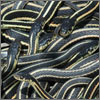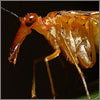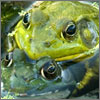
Mating Trickery
Giant cuttlefish off the coast of Australia, long known as
masters of camouflage, can use their color-changing abilities
in a remarkable act of sexual deception: smallish males, unfit
for winning wrestling matches with stronger rivals, disguise
themselves as females in order to elude their adversaries and
discretely mate with the genuine article. It's astounding, but
not entirely unusual. The animal kingdom is rife with such
"sneaker" males as well as an array of courtship and mating
tactics more devious than any found in a Harlequin romance.
Below, meet a menagerie of fish, insects, reptiles, and
mammals with intriguing sexual strategies.—Nicole Duarte and Susan K. Lewis


|
|
Bluegill Sunfish
Lepomis macrochirus
In the mating game, male bluegills don't have just a
single strategy for success; they have three. Most males
take a conventional approach—becoming big and
brawny. Their physical prowess allows them to build and
defend nests from predators, and females spawn in their
domains. But when a female enters a nest, she may be
followed by a male similar to her in size and
coloration. The territorial male may not notice this
stealthy rival, who has come to fertilize the eggs he
will protect. The third sort of male, the smallest of
all, attempts to dive in amongst a mating territorial
male and a female and add his sperm to the mix. Both
types of non-territorial males reach sexual maturity
years before the large nest-guarding type, and both are
free to flit from nest to nest to try their wiles. The
territorial males have countertactics, however. They can
"taste" the eggs in their nests, distinguishing and
saving those they have sired and devouring the rest.
|


|
|
Fruit Fly
Drosophila melanogaster
Females across the animal kingdom—from insects to
mollusks to mammals—often hedge their reproductive
bets by accepting the sperm of multiple males to ensure
that their eggs will be fertilized. This leads to
so-called "sperm competition," and in the common fruit
fly, the sperm of the last male to copulate with a
female often displaces rival sperm and wins out. Males
can employ a strategy, however, to prevent such
rematings: they release a pheromone in their seminal
fluid that acts as an anti-aphrodisiac. It marks the
female with the scent of a male, making her less
attractive to subsequent suitors, at least for several
hours. The chemical cocktails in the male's semen
enhance his reproductive success but may be costly to
her; it's thought that the compounds decrease female
longevity.
|


|
|
Side-Blotched Lizard
Uta stansburiana
Male side-blotched lizards are engaged in what
herpetologist Barry Sinervo likens to a game of Rock,
Paper, Scissors. There are three types of males, and
whether one type triumphs in a particular match depends
on which of the other two it is up against. One morph of
male has a yellow throat. It resembles a female and can
sneak into the territory of an orange-throated male to
pair up with one of the orange throat's harem. To keep
the ultra-aggressive orange throat at bay, the yellow
throat bobs his head just as a female unreceptive to
mating would do. But yellow throats can't pull the same
trick with the third morph, blue-throated males. When
yellows try to invade blue-throat territory, the blue
throats, which are monogamous, quickly recognize the
intruders and chase them away. The blue males even
cooperate with neighboring blue males to drive off
yellow "sneakers" and overtly aggressive oranges, at
times sacrificing their own lives for the sake of their
blue brethren.
|


|
|
Red-Sided Garter Snake
Thamnophis sirtalis parietalis
Sometimes outcompeting a rival suitor involves
attracting his attention.
In the mating frenzy that takes place each spring among
red-sided garter snakes, a hundred males may descend
upon a single female emerging from her winter den.
Within the resulting writhing mass, some males
chemically mimic females, emitting a pheromone so
alluring that other males pursue them rather than the
female. Biologists hypothesize that this tactic allows
the mimics to snake their way to the true female while
their competitors are confused. This mimicry can come at
a cost, however: at times, the mimics are mobbed by
excited males even when no female is around, and they
all lose out on a chance to mate. On the other hand, the
warmth of the pursuing males heats up the mimic, which
has only a 0°C body temperature when he emerges from
his den, and thus may enhance his fitness to survive.
|


|
|
Common Scorpionfly
Panorpa communis
Female scorpionflies expect dinner before they mate. A
male will approach a female bearing what biologists term
a nuptial gift—a prey insect or a gob of secreted
saliva that she will find tasty. While she munches, the
male copulates with her, and the bigger the present, the
longer the male has for insemination. However, not all
males want to pay for dinner. Some cunning fellows will
assume the posture and behavior of a receptive female,
then, when another male offers "her" a gift, the
impersonator will snatch it and dart off. If the thief
is successful, he'll turn around and offer his stolen
gift to a female, with the chance, of course, that "she"
might actually be another thief.
|


|
|
Spotted Hyena
Crocuta crocuta
Many cases of males mimicking females exist in the
animal world, but spotted hyenas turn this ruse around.
Female hyenas have an enlarged clitoris that closely
resembles the male's penis, and biological
anthropologist Martin Muller speculates that this trait
evolved, in part, by protecting young females from
attack. Hyena prides are ruled by a dominant female that
holds her position vis-à-vis other females
through fiercely aggressive behavior, which can even
include infanticide. Infant females that pass as males
might avoid such a fate and survive, unlike their more
obviously female counterparts.
|


|
|
Green Frog
Rana clamitans melanota
A call-and-response courtship leads female green frogs
to their mates, with females gauging the attractiveness
of potential partners by their love songs. In this
exchange, smallish males sometimes imitate the
low-pitched vocalizations associated with larger, more
desirable mates. Other males, called satellites, rather
than talk the talk, station themselves near deep-voiced
rivals and attempt to intercept approaching females.
Male crickets practice similar tactics: some sing
loudly—luring predators as well as
females—while satellite male crickets wait by at a
safe distance to catch females crawling in. If few
predators are around, the singing strategy likely wins
out, but when danger abounds, it pays to remain silent.
|


|
|
California Tiger Salamander
Ambystoma californiense
Reproductive success often involves undermining the
competition. Male tiger salamanders encase multitudes of
sperm in packets called spermatophores, which they
secrete in the paths of females after an elaborate
mating dance. In the standard version of the ritual, a
female picks up the spermatophore with her genitals. But
in a con game, a male assumes the role of a dancing
female and then destroys his rival's genetic material. A
male mimicking a female can also join a mating pair and
deposit his spermatophore on top of his rival's. The
female will take only the spermatophore on top, wasting
the efforts of the first male.
|


|
|
Bedbugs
Cimex lectularius & Afrocimex constrictus
Mating amongst bedbugs isn't pretty. The namesake
species responsible for itchy welts on human victims,
C. lectularius, practices "traumatic copulation."
With a saberlike penis, males puncture the abdomens of
females to inseminate them. Interestingly, the females
can benefit from this violent act by using the sperm for
nutrition as well as to fertilize eggs. In another
species, A. constrictus, which lives on African
bats, males possess a genital structure closely
mimicking that of the female. They entice other males to
mate with them and can feed off the sperm, but the
greater aim is simply to diminish the reproductive
capacity of their competitors.
|
|


We recommend you visit the
interactive version. The text to the left is provided for printing purposes.
|










